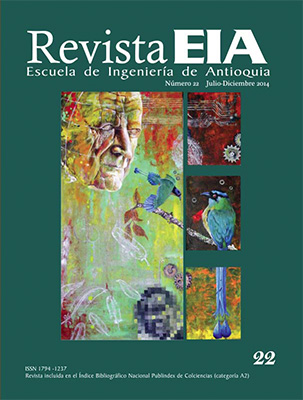DISEÑO ESTADÍSTICO PARA LA REMOCIÓN DE ROJO BÁSICO 46 UTILIZANDO TIERRA FULLER REGENERADA COMO MATERIAL ALTERNATIVO
DISEÑO ESTADÍSTICO PARA LA REMOCIÓN DE ROJO BÁSICO 46 UTILIZANDO TIERRA FULLER REGENERADA COMO MATERIAL ALTERNATIVO


This work is licensed under a Creative Commons Attribution-NonCommercial-NoDerivatives 4.0 International License.
Copyright statement
The authors exclusively assign to the Universidad EIA, with the power to assign to third parties, all the exploitation rights that derive from the works that are accepted for publication in the Revista EIA, as well as in any product derived from it and, in in particular, those of reproduction, distribution, public communication (including interactive making available) and transformation (including adaptation, modification and, where appropriate, translation), for all types of exploitation (by way of example and not limitation : in paper, electronic, online, computer or audiovisual format, as well as in any other format, even for promotional or advertising purposes and / or for the production of derivative products), for a worldwide territorial scope and for the entire duration of the rights provided for in the current published text of the Intellectual Property Law. This assignment will be made by the authors without the right to any type of remuneration or compensation.
Consequently, the author may not publish or disseminate the works that are selected for publication in the Revista EIA, neither totally nor partially, nor authorize their publication to third parties, without the prior express authorization, requested and granted in writing, from the Univeridad EIA.
Show authors biography
RESUMEN
Diferentes materiales no convencionales han sido evaluados en los últimos años como adsorbentes para el tratamiento de efluentes coloreados provenientes de la industria textil. La tierra fuller (TF) compuesta por distintos minerales, ha presentado una alta capacidad para la remoción de diferentes colorantes catiónicos, no obstante el rojo básico 46 (RB46), ampliamente utilizando en los procesos de tinción no ha sido estudiado sobre este material. En esta investigación se evalúan las mejores condiciones para alcanzar la mayor remoción del RB46 sobre TF mediante un diseño estadístico de experimentos bajo sistema discontinuo. Las variables analizadas fueron dosis de adsorbente, concentración de colorante y tiempo de contacto. La concentración final del colorante se cuantificó por espectrofotometría UV-Vis. Un diseño factorial 23 y su posterior optimización a través de un diseño de superficie de respuesta central compuesta permitió alcanzar una remoción máxima del 99,07 % a una concentración de 35,0 mgL-1, una dosificación de 1,1 gL-1 y un tiempo de contacto de 8 h con un coeficiente de correlación ajustado del 96,79 %.
ABSTRACT
Several non-conventional materials have been evaluated in recent years as adsorbents for the treatment of colored effluents from the textile industry. Fuller’s earth (TF) which is composed of various minerals has shown a high capacity for removal of different cationic dyes, however the basic red 46 (RB46) widely used in dyeing processes, has not been studied on this material. In this research were evaluated the best conditions to achieve the higher removal of RB46 on TF through a statistical design of experiments under batch system. The analyzed variables were adsorbent dosage, dye concentration and contact time. The final concentration of the dye was quantified by UV-Vis spectrophotometry. A factorial design 23 and its further optimization through a central composite surface design allowed to achieve a maximum removal of 99.07% at a concentration of 35,0 mgL-1, a dosage of 1,1 gL-1 and a contact time of 8 h with an adjusted correlation coefficient of 96.79%. TF is an excellent material for the removal of RB46 since it requires a lower dosage for high concentrations of the dye compared with those reported for other adsorbents.
Article visits 326 | PDF visits 160
